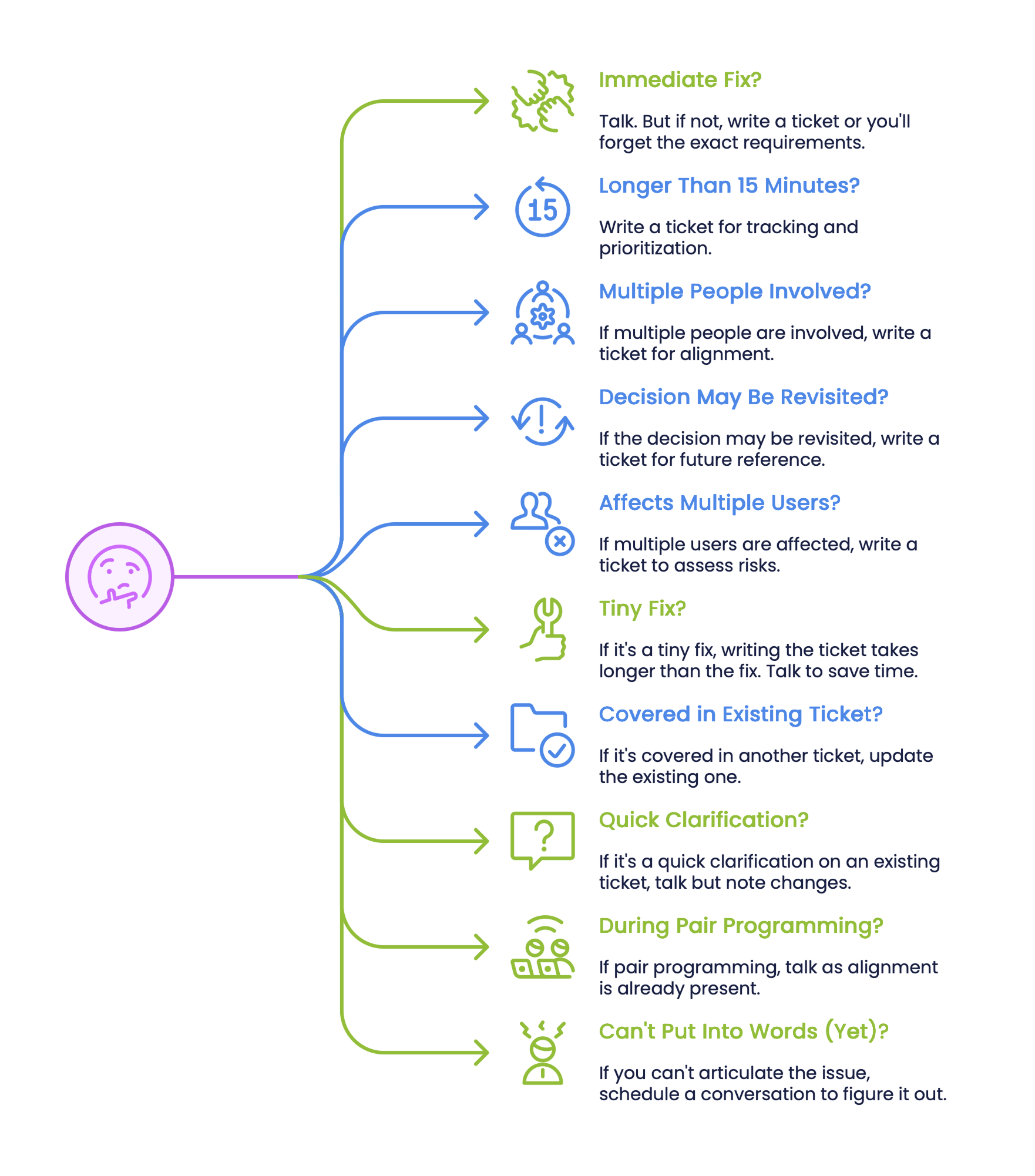Ticket or Talk? When to Write a Ticket vs. Speak Directly to the Team

We All Do It From Time to Time
In every agile team, one question shows up more often than it should: Should we write a ticket for this? Or should we just talk about it quickly and get it done? Writing a ticket for every small fix or short idea feels like a huge burden.
Everyone has done it: You spot an issue or have an idea and your first instinct is to walk over to your colleague and say, “Hey, this just happened – can we fix it?” That kind of quick interaction feels natural. As humans, we seek direct feedback and confirmation. Walking over to my colleague is the quickest way to get this done. I don’t have to open Jira and find the right words to write an understandable ticket.
But here’s the thing: It’s the quickest way to get this done – for you. Every time you start that conversation, you interrupt someone’s flow. And in product and dev work, regaining focus takes time.
Written communication helps here. It gives your team space to stay focused, and it forces you to be precise. That’s not bureaucracy – that’s respect for everyone’s time.
And that’s not the only thing: Writing things down brings clarity and makes it easier to understand later why a decision was made. It also helps keep an overview – especially as your team grows and more people need context. If you don’t write it down, things get forgotten, misunderstood, or worse – implemented the wrong way. Because what feels clear in the moment can get blurry hours or days later, especially if someone picks it up without the full background.
To sum it up: If everything becomes a ticket, you drown in admin work. If nothing gets written down, decisions disappear. Both extremes seriously hurt your team’s agility.
This article helps you figure out when to write a ticket and when a quick conversation is enough. It’s not about one being better than the other – it’s about knowing when to use which tool, so you avoid misunderstandings, wasted time, and chaotic refinements.

What Happens If Agile Teams Don't Write Good Tickets
You’ve probably heard something like: “Tickets are just an invitation to a conversation.” Or worse: “We don’t need tickets, we just talk to each other.” Sounds agile? Sure. But often, what actually happens is this:
- Agreements get lost because nothing was written down
- People forget what exactly was discussed
- New team members have zero context
- You lose track of what was actually implemented and what was not
- Refinement becomes a game of guessing what someone meant
- Worst case: Things get implemented the wrong way and what users actually need is lost
And let’s not forget the long-term benefits: tickets let you revisit what decisions were made, who gave input, and how a feature evolved. This kind of traceability becomes essential once your team grows or as your product matures. It’s not about process for the sake of process – it’s about not losing the knowledge your team creates every day.
How to Choose Between Talking and Ticketing in Agile Communication
Writing tickets takes time. So does not writing them.
Skipping tickets saves time now, but you often pay back that time later with interest: clarification meetings, repeated questions, avoidable bugs. On the flip side, if you ticket every tiny thing, you drown in overhead. Balance matters.
Short, real-time chats can unblock something quickly. But tickets capture intent, dependencies, and product decisions that matter over time. They’re also searchable. That tiny alignment point you made in a hallway chat? It’s lost forever if it’s not documented. But if it’s in the ticket? It lives on.
Writing a good ticket doesn’t mean writing a novel. It means giving just enough context so your future self, your developer, or your tester doesn’t have to play detective later.
When to Write a Ticket: A Decision Tree With Key Criteria to Consider
Ask yourself the following questions to know when to write a ticket and when a quick conversation is enough:
Know your context, and choose accordingly.
Turn Talk into Action: How to Document Decisions (It’s So Easy That It Feels Like Cheating)
Also, not every ticket needs to be a perfectly refined user story. Sometimes a rough placeholder is enough. The key is knowing which level of clarity you need:
- Placeholder ticket: Good when the topic is still fuzzy but you want to make sure it doesn’t get lost.
- Working ticket: Used during refinement to capture the main context, edge cases, and value.
- Final ticket: Clear, testable, well-described – ready for sprint planning.
You clarified everything that was unclear with a team member? Now open ChatGPT, use the speech-to-text function, and just explain out loud what you and the team just agreed on. If you sketched something out on a whiteboard, you can share that too. Let the AI summarize the key points and turn it into a proper issue for you.
Or even better: use an AI tool that listens to your meetings and suggests follow-ups, or like Product Copilot, is directly integrated in your issue tracker and creates the tasks directly in Jira, knowing your sprint context and the way your team works.
Having AI accessible is the most important thing if you actually want to use it to make life easier.